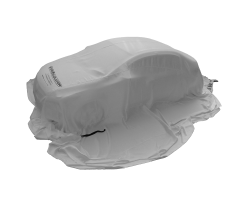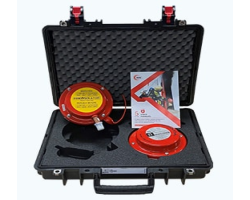A Fire Isolator Case Study : Combating Electrical Vehicle Fires Aboard Transport Ships

Introduction to Electrical Vehicle Fire Safety
As the popularity of Electric Vehicles (EVs) continues to surge, ensuring their safety has become a paramount concern. This article delves into the evolving realm of EV fire safety, exploring the processes and conditions that can lead to electrical fires. It highlights the pivotal role of groundbreaking products like the Fire Isolator in this landscape. Specifically, we examine a recent EV fire incident involving a cargo ship in the Netherlands, which carried electric vehicles. Through this case study, we underscore the benefits of leveraging the Fire Isolator system to effectively address critical situations that may arise in the future.
Why the Rise of Electrical Vehicles?
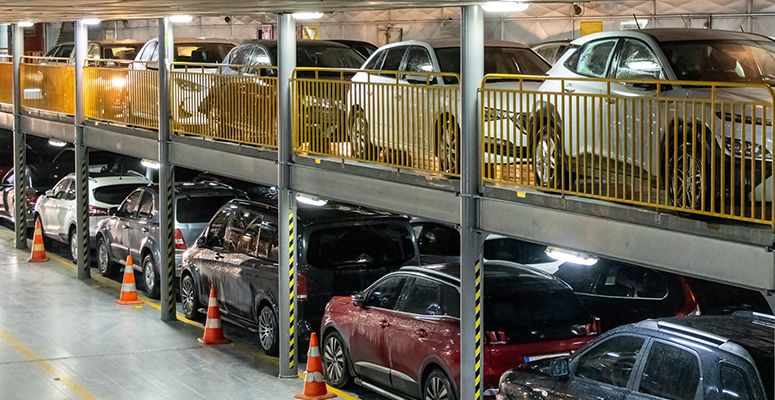
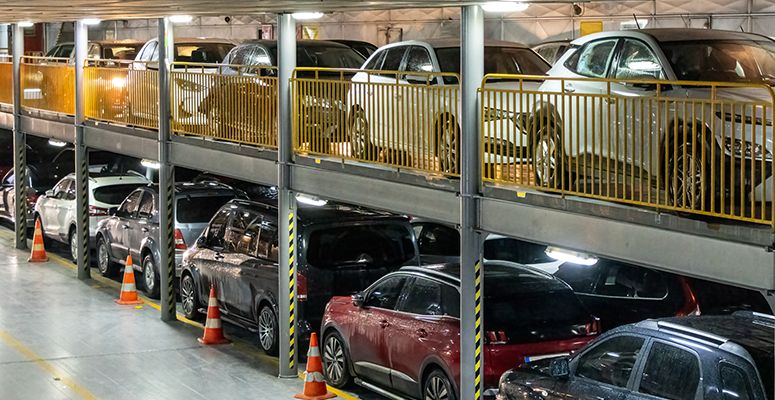
"We’re certainly seeing a huge push around decarbonisation,
and the car industry has led in the development of battery technology and alternative fuel vehicles for this purpose" (McLoughlin, 2022)
The year 2021 witnessed a remarkable surge in Electric Vehicle (EV) sales across major automotive markets, including China, the US, and Europe. Notably, sales in the first half of the year spiked by an impressive 160%, totaling 2.6 million units. This surge accounted for 26% of new sales in the global automotive market. Within Europe, the Nordic countries, particularly Norway, stand out as leaders in this electric revolution (fireisolator.com, 2023)
As the number of electric vehicles on the road continues to grow, an uptick in their involvement in traffic incidents is foreseeable due to their increasing presence. Additionally, the potential for battery cells to unexpectedly ignite or explode during charging poses a concerning environmental and safety threat to their surroundings.
In recent years global electric vehicle (EV) movement is gaining remarkable traction around the world. For example, in the UK alone, statistics from the Department for Transport and the Office for Zero Emission Vehicles put forth that the number of EV registrations in the north of England has doubled to 74,677 since 2021 (Gov.uk, 2022). This surge is a testament to the government's efforts to usher in a cleaner and more affordable era of transportation, resulting in the creation of tens of thousands of green jobs across the nation. Nationally, plug-in vehicle sales have skyrocketed by over 70%, with a record-breaking 327,000 plug-in vehicles registered in 2021, marking a substantial 77% surge compared to the previous year (Gov.uk, 2022).
As the UK's transport revolution unfolds, it underscores a commitment to robust infrastructure, efficient transport networks, and economic growth across regions. The government's Electric Vehicle Infrastructure Strategy, backed by a substantial £1.6 billion funding, seeks to amplify on-street EV charging capabilities by a factor of ten, thus alleviating the common concern of 'range anxiety' while promoting wider EV adoption. By 2030, the UK aims to establish 300,000 public electric vehicle chargepoints—equivalent to almost five times the current number of fuel pumps on the roads. This impressive progress is supported by the installation of around 600 new public chargepoints each month, underscoring the UK's leadership in the global shift to electric vehicles (Gov.uk, 2022).
Moreover, this transition is more than just a shift in transportation; it's a catalyst for positive change. The push towards emission-free travel has yielded up to 40,000 new automotive jobs and a substantial 11% reduction in average carbon dioxide emissions for cars, indicating a cleaner and healthier environment. With a commitment to phasing out new petrol and diesel cars and vans by 2030, the UK is driving toward a net-zero transport future, ensuring all drivers can access EVs with their lower operational costs. This transformative journey, reinforced by substantial investments and industry support, is cementing the UK's role as a leading hub for the design, manufacturing, and utilization of zero-emission vehicles, cultivating economic growth, employment, and environmental sustainability (Gov.uk, 2022).
Understanding Electrical Vehicle Fire Risks
As evident with their sustainable and green capabilities as seen within the UK, electric vehicles bring numerous benefits to both indivduals in terms of jobs, and societies as a whole, but, they also come with specific safety concerns related to their high-voltage battery systems. This is because electric vehicles predominantly rely on rechargeable lithium-ion batteries as their primary power source (Tesla, 2006). These batteries, initially developed in the 1990s, found their first application in powering cars during the early 2000s. In contrast, traditional petrol and diesel vehicles have a history spanning well over a century 'with transportation fuel for humans began in 1858' (ypte.org.uk), providing a much longer time-frame for accumulating safety-related data and insights.
While electric vehicles are inherently designed with a high level of safety, one of the primary concerns arises when dealing with potential damage to the lithium-ion battery. Such damage can occur if the battery is exposed to extreme heat or if an object punctures the protective barrier of a battery cell.
In essence, electric vehicles are built with safety as a fundamental principle. However, due to the relative recency of their introduction compared to traditional vehicles, there is still a need to gather and comprehend extensive data about their long-term safety performance. The critical point of concern remains the condition of the lithium-ion battery, which demands careful handling to prevent scenarios involving extreme temperatures or physical breaches to the battery's integrity.
Factors contributing to EV fire risks include thermal runaway, short circuits, and external factors like collisions. For example, in the case of lithium-ion batteries, commonly used in EVs, are susceptible to thermal runaway, a condition in which the battery heats up uncontrollably, potentially leading to fires and explosions.
An EV fire is also harder to extinguish and may re-ignite. Re-ignition of the battery occurs when other nearby cells within the battery pack become damaged in the initial incident and go into thermal runaway sometime after.
Thermal Runway: An Electical Vehicle Fire Phenomenon?
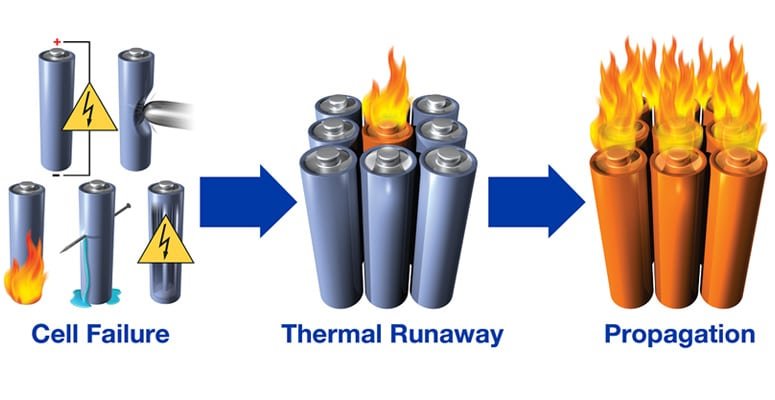
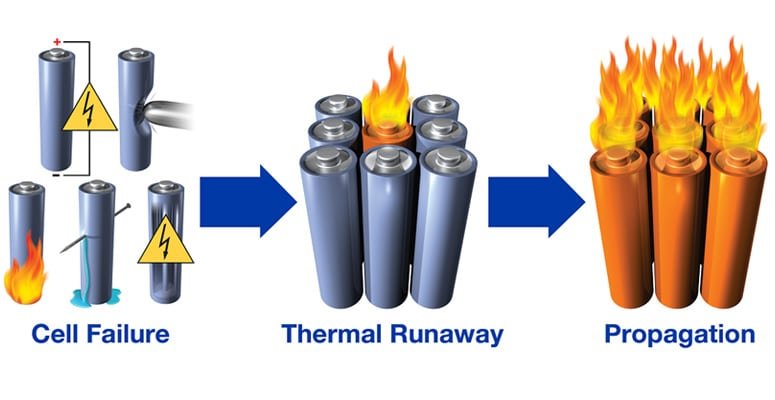
Thermal Runaway is an occurrence of a series of self-sustaining heat-releasing reactions within the battery, caused by high temperatures or voltage trigger chemical reactions within a battery cell. These reactions overpower the battery's cooling mechanisms, leading to ignition. If ignition occurs, nearby battery cells might also undergo thermal runaway. As a result, the likelihood of fire increases with the number of cells experiencing this runaway, potentially causing the entire battery to fail.
Remarkably, thermal runaway can transpire even at relatively low temperatures (Kong et al. 2023) and at low pressures (Xie et al. 2020). In such cases, battery failure may involve the release of flammable gases and an increased amount of gas release (Jia et al. 2022) In fact, the process generates around 100 organic chemicals, including highly toxic gases (Held et al. 2022) like carbon monoxide and hydrogen cyanide. These gases can ignite if an ignition source is present or if the environment provides conditions suitable for combustion, such as ample oxygen, a fuel source, and heat.
This inherent risk is magnified in emergency situations like ship fires, especially if electrical vehicles are on-board being transported within an enclosed area like a car park or cargo holding, as North of England P&I Club’s Director of Loss Prevention, Colin Gillespie states in an article about safe carriage aboard vessels that they are examining ships that were not initially constructed to accommodate electric vehicles and other types of alternative-fueled vehicles. It's possible that the crew may not possess the training needed to identify or appropriately manage such fire scenarios (lr.org, 2022)
In short, addressing these challenges is crucial as we navigate towards safer and more sustainable transportation options in relation to electrical vehicles within maritime enviroments.
EV Fires & Maritime Enviroments
In maritime contexts, the potential for EV fires poses unique challenges due to the confinement of space and limited means of escape. When a ship fire occurs, the combination of an enclosed environment, the presence of multiple electric vehicles with lithium-ion batteries, and the proximity of these vehicles to each other can create conditions conducive to a quick spread of fire. The confined space restricts the dissipation of heat and gases, potentially intensifying the severity of the fire.
Furthermore, the nature of ship fires often involves a complex interplay of factors such as restricted accessibility, limited firefighting resources, and the need to manage the safety of both crew members and passengers. If an EV fire ignites within a confined space like a cargo hold or car park area on a ship, the potential for thermal runaway to spread to neighboring battery cells and vehicles could escalate the situation.
Addressing this challenge requires specialised strategies and technologies tailored to maritime settings. Innovative fire safety solutions and EV fire safety equipment, like the Fire Isolator system, which can rapidly disconnect high-voltage battery systems and contain thermal runaway, play a crucial role in preventing the escalation of EV fires in such confined spaces. The emphasis on collaboration between ship operators, manufacturers, regulatory bodies, and fire safety experts becomes paramount to ensure effective strategies are in place to mitigate the risks associated with EV fires in maritime emergencies.
Mitigating Electrical Vehicle Fire Risks - A Case Study from Netherlands Cargo Ship Incident


As mentioned earlier, lithium-ion batteries, commonly used in EVs, are susceptible to thermal runaway—a condition in which the battery undergoes uncontrolled heating, potentially leading to fires and explosions. This risk is significantly heightened in critical situations like ship fires, particularly within maritime environments where both the ship and the staff may be ill-prepared for the consequences of an electrical fire incident.
Which brings us to our case study.
A cargo ship named the "Freemantle Highway" experienced a catastrophic fire in the North Sea. Among the cargo electrical vehicles with a lithium-ion battery that contributed to the fire's intensity. Out of the total 3,783 vehicles aboard the Freemantle Highway, it has been stated that electric vehicles (EVs) accounted for approximately 13.2%, with a count of 498 units of EVs on-board during the time of the incident (cbsnews.com, 2023).
The fire erupted off the coast of the Netherlands, prompting the complete evacuation of the crew and tragically resulting in the loss of one seafarer's life.
Although there exists claims that the fire itself was not caused by an electrical vehicle fault, the fact remains that having such a concentrated number of EVs on-board likely contributed to the catastrophy. And in support of this, there have been unoffical / leaked images from the burned cargo Evs seen at the site of the incident — including cars which are fully electric.
As a whole, this further underscores the paramount importance of possessing the right safety equipment to combat electrical fires, coupled with comprehensive EV fire training to ensure EV fire control, and allowing effective prevention and turn, elimination of future electrical fire incidents aboard large vessels and transport ships that are carrying electrical vehicles, or cargo at risk of electrical fires.
The Solution? Fire Isolator System: Made for EV Fires. Tested Accordingly.
"The Fire Isolator is a concept to minimise the collateral damage and control of an EV fire, up to a point where you can safely remove the car"
- Jan Peter Verheuvel
The Fire Isolator is a revolutionary solution tailored to tackle this pressing issue. Its primary focus is on isolating and battling EV car fires, where the presence of highly hazardous lithium-ion batteries demands specialised attention — as seen by our previous case study of the Netherlands cargo ship incident. With a track record of being thoroughly tested and highly effective, the Fire Isolator has undergone rigorous trials, emerging as a product of choice. Developed in collaboration with professional firefighting crews experienced in addressing these very challenges, the Fire Isolator is the outcome of extensive practical insights.
The uniqueness of the Fire Isolator equipment lies in its ability to bolster safety by isolating EV fires effectively. The product's comprehensive approach includes multiple firefighting methods and materials, substantially increasing the likelihood of successfully isolating fires by up to 500%. Recognising the complexity of extinguishing fires in lithium-ion batteries, the Fire Isolator system employs specialised equipment and techniques to ensure complete and secure extinguishment or isolation.
In the ever-evolving landscape of electric mobility, fire safety remains a paramount concern. The the Fire Isolator, born out of collaboration, innovation, and rigorous testing, stands as a next generation electrical fire-fighting technique—a solution that not only addresses the challenges of EV fires but also showcases the power of technology to protect lives and property. As we navigate toward a future marked by sustainable transportation, the FIRE ISOLATOR emerges as an indispensable tool, safeguarding against the unexpected and championing the safety of electric vehicles and the spaces they inhabit.
VR0906Li Fire Isolator Blanket
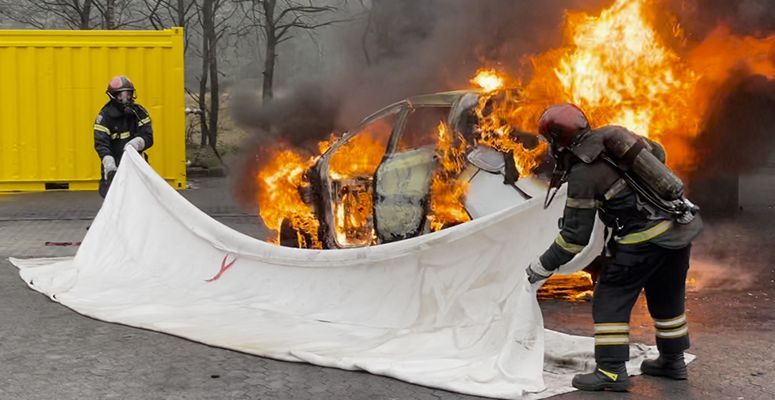
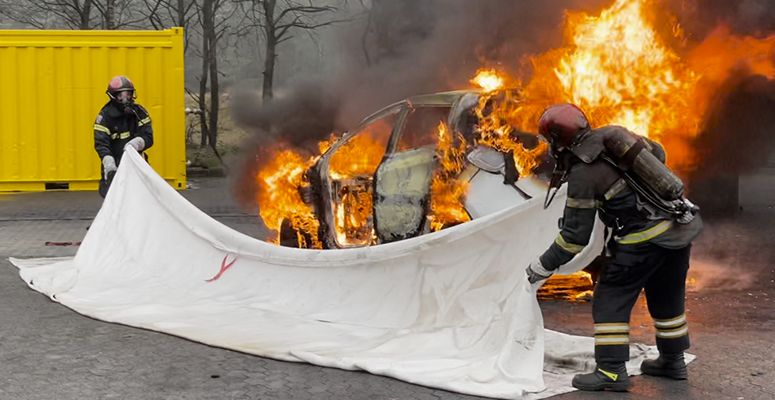
Two Years of Intensive Research. Design & Testing.
When dealing with electrical fires, it's crucial to recognize that by cutting off the fire's oxygen source and containing the smoke, the resulting damage from the fire can be significantly minimised. This approach not only helps to reduce repair costs but also offers a safer method of fire extinguishing for crews. At the heart of the Fire Isolator's innovation lies the fact that it transcends the role of a mere 'fire blanket.' Instead, the Fire Isolator represents a comprehensive strategy aimed at not only controlling the electrical fire itself but also minimizing collateral damage. With the ability to withstand temperatures up to 1600 degrees Celsius (supported by an ISO test certificate) for over 50 hours, the Fire Isolator is truly impressive.
Deployment: Deploying the Electric Vehicle (EV) Fire Blanket is a streamlined process that only requires just two individuals. This would make it particularly valuable when operating on vessels with limited trained crew members. Once positioned over an electric vehicle (EV), the Fire Isolator Aerosol Units can be activated to further diffuse the situation.
By using multiple ways and materials of EV car firefighting, you increase the chances of safely isolating the fire. The Fire Isolator Electric Vehicle Blanket can be used for normal, combustion-engine and EV car fires. It is also designed to be deployed in parking garages, parking lots, onboard ferries and ocean-going vessels.
Aerosol Salt Potassium Unit

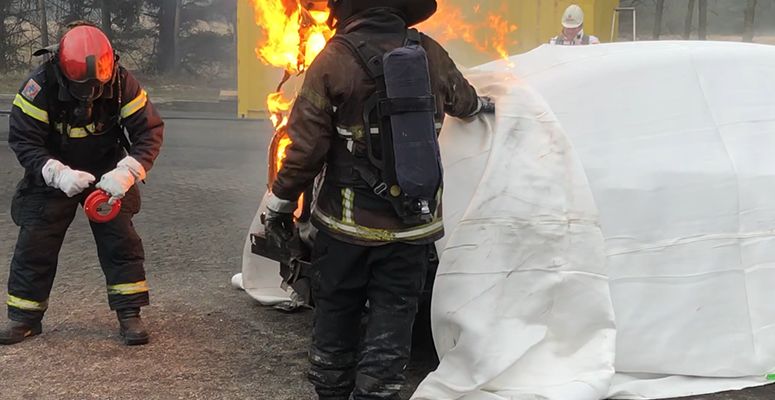
Lightweight, Handheld Device. Controls EV Fires.
The Aerosol Potassium Salt Unit serves a critical role by enabling the first responder on-site to activate and deploy it within an area affected by an EV fire. Once triggered, the device functions automatically. Its effectiveness becomes particularly noteworthy in enclosed spaces like cargo vessel holding bays, where the potential impact is substantial. Depending on the space's volume, the unit works to extinguish the fire or significantly diminish its intensity upon contact. Designed with a focus on heat reduction and the reduction of water or foam requirements, it also minimises damage to the affected area or contents, leaving minimal to no residue.
How to Activate: Straighten the ends of the pins and pull the pin out. Once the pin is removed, you will hear a click. This click serves as a notification to the user that the unit is now activated and will commence producing aerosol in approximately 6-8 seconds. Within 40 seconds, the contents of the EV firefighting equipment are fully dispersed.
Specifically tailored for controlling electrical vehicle fires, the Aerosol units offer a practical solution. Fire Isolator Aerosol Units are handheld and lightweight devices, that cater to the immediate needs of first responders in fire situations — primarily for Class A, B, and C fires. Its functionality is straightforward: empowering the first responder to activate and throw the unit into the fire-affected area, facilitating swift and effective fire control. This strategic tool aligns with the concerns of those seeking reliable solutions for fire safety in the realm of EVs.
Water Mist Lance


For Controlling Fires within a Container & Flooding EV Car Lithium Batteries.
The Fire Isolator Water Mist Lance is your ally in swiftly and effectively extinguishing fires caused by electric vehicles.
Engineered to align with SOLAS regulations II-2/10.7.3, which pertain to the suppression of fires within confined spaces including containers, the Fire Isolator Water Mist Lance stands as a robust solution designed to meet rigorous safety standards. In accordance with these regulations, vessels constructed from January 1, 2016, onwards, intended to carry containers on or above the weather deck, are mandated to have at least one water mist lance on board.
Directions for Use: Using the Fire Isolator Water Mist Lance is a streamlined process. A specialized expert will carefully drill the lance directly into the battery, selecting an easily accessible point. This enables water to directly enter the battery cells, with the lance requiring only a minimal insertion depth. Beyond this, the lance is equipped to penetrate container walls. When connected to the fire main, it generates a controlled water mist within the container, establishing a safe and efficient method for combating fires on board a ship.
This particular model serves a dual purpose. Not only does it effectively contain fires within containers, but it also showcases its adaptability by addressing the unique challenge of inundating EV car lithium batteries during fire situations. The Water Mist Lance's versatility extends to its adjustable shaft length, ranging from 500mm to an impressive maximum of 1350mm. Crafted from stainless steel, the lance's top shaft is PE-coated to provide insulation against electric shock. Upon connection to a water supply, the lance dispenses a fine water mist within the container, bolstering firefighting endeavors.
Conclusion: Bridging the Gap Between Innovation and Demand


In conclusion, the presented article delves into the crucial realm of electric vehicle fire safety, highlighting the multifaceted challenges posed by these incidents and the imperative need for innovative solutions.
As the electric vehicle landscape continues to expand, the potential risks associated with EV fires demand proactive measures and advanced tools. The comprehensive insights shared in this article shed light on the nuanced complexities of addressing EV fires, from understanding thermal runaway phenomena to introducing cutting-edge products like the Fire Isolator.
By bridging the gap between emerging technology and enhanced safety protocols, this article underscores the pivotal role of collaboration between industry experts, regulatory bodies, and manufacturers. As we navigate towards a more sustainable and electrified transportation future, prioritizing fire safety remains paramount, and solutions like the Fire Isolator system — pave the way for safer journeys alongside protected land and marine environments.






